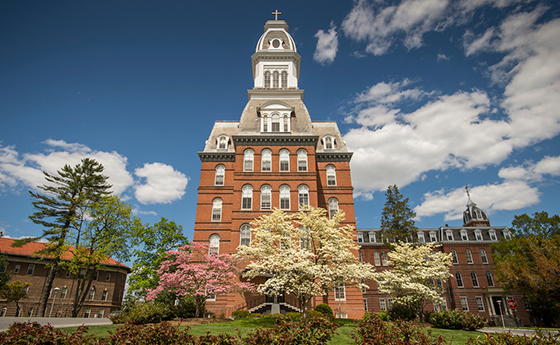The student-led organization improves communication between students and administration.
By Micah Castelo

On January 29, the Notre Dame community received an email about nominations for the Student Advisory Council (SAC). With prior news about the co-education idea presented to the Board of Trustees, the reunification of the student-run committee seemed more than timely. After receiving the notice, students, faculty, and staff began nominating potential members in hopes of bridging the gap of understanding between students and administration.
Originally created in 2015 following the Baltimore Uprising against police brutality, the Student Advisory Council is not a new concept. During that spring, several members of the Notre Dame community marched up and down North Charles Street with signs on hand, demanding justice and peace after the death of 25-year-old Freddie Gray.
At the same time, many students were moved to speak out on issues of inclusivity and equity at Notre Dame, claiming that the university was “not keeping up with its mission of social justice,” a criticism sparked by the administration’s failure to successfully respond to the racial tensions in the city. In a list of demands, concerned students called for increased representation of POC students and faculty, required race-related courses and discussions, and timely notice about events that would affect students socially, mentally, and emotionally. To acknowledge and act on student concerns such as those, the Student Advisory Council was born.
According to Kelly Hoover, Notre Dame’s Associate Vice President for Student Life, the main goal of the Student Advisory Council is to “provide direct and unfiltered advice to the president and other senior administrators on a regular basis.” As a cohesive group, the Student Advisory Council will ensure that the university’s leadership is attentive and responsive to student perspectives, concerns, and issues.
“We hope that this group will continue to help illuminate the student experience, particularly in regards to creating a campus where inclusion isn’t just professed as a value, but experienced by the community,” says Hoover. “I think that being able to identify areas where NDMU is already strong while taking a critical look at where we can improve will help the institution progress.”
All members of the Notre Dame community were invited to nominate qualified students. The nomination process involved filling out an online form and stating what makes the person qualified to serve on the Student Advisory Council. Next, the Student Life staff reviewed the nominations—23 in total—and selected a pool of 10 students who they believed would represent the university well based on their nomination, class year, and program. Unlike the Concerned Students, a similar group that fights for student concerns, the Student Advisory Council requires representatives from each of Notre Dame’s four main schools.
Jessie Willinghan, a sophomore business major, was one of the 10 students selected. Willinghan knew that she wanted to be on the Student Advisory Council from the moment she received the call for nominations email. Over the past year, Willinghan saw herself becoming more involved on campus, exposing her to different perspectives and issues. “For example, a few weeks ago, when everyone was afraid we would go co-ed, I saw a necessity for increased transparency between students, the administration, and the Board of Trustees,” she explains. “I was ecstatic when I found out I was selected.”
But the Student Advisory Council does not only serve those in the women’s college; it also provides an opportunity for other schools like the College of Adult Undergraduate Studies to be heard. For Key Spriggs, a senior liberal arts major with a concentration in professional studies and social sciences, being a member of the council was an honor and a way to advocate for the university’s adult education program. “I want to help other women like myself reach their goals. My professors here have been the best, and they have made an impact on my life. I want to do the same as a member of this council,” she says.
Indeed, the Student Advisory Council aims to include all student perspectives. Catherine Chiarizio, a junior political science major, is a military veteran and older transfer student who is currently using the GI Bill to complete her education. She says that this background allows her to bring unique perspectives to the council. “I hope to see and promote more military veterans here at Notre Dame,” Chiarizio expresses. “I know it’s a great fit for veterans to evolve and grow through their shared vision of personal and worldly transformations.”
Besides Hoover, the convener and logistics organizer of the Student Advisory Council, there are no faculty or staff members who lead the group—both the agenda and the conversation are student-driven.
“This council is important because hearing and listening to students’ concerns, solutions, and definitions of success and how to achieve that are all thoughts and ideas I need to hear,” explains Dr. Marylou Yam. “We all benefit, in the short and long-term, from hearing directly from our students.”
The Student Advisory Council is just one way to formally meet students and hear about what is on their minds. For instance, during the academic year, the administration plans gatherings like Coffee and Conversations with Dr. Yam, Open Student Forums, and scheduled dinners in the dining hall with students. “Also, students are always welcome to stop by my office and talk during open hours,” says Dr. Yam. “Even if they see me walking down the hallway or across campus and they want to talk, I will make the time.”
Ultimately, the members are excited to start assembling. Their first meeting will take place early this month.
“Above all else, I hope that the Student Advisory Council will increase communication and transparency between the students, administration, and Board of Trustees,” says Willinghan. “One of the most amazing aspects of Notre Dame is how involved everyone is in our community, and having an open dialogue at all levels will help foster that.”
Photo by courtesy of NDMU

Leave a comment